 Bob Farrell is a legend on Wall Street.
Bob Farrell is a legend on Wall Street.He built Merrill Lynch into a market powerhouse, capitalizing on the markets in the mid-1960s, mid-80s and during the big downturns in the ’70s and Black Monday in ’87.
Over his decades in the teeth of the greatest and fiercest markets in modern history, he put together a list of 10 rules that are key for any investor or student of the markets. One good detailed explanation of the list is here.
Given where we are right now, I think it’s crucial for you to keep a copy of this list bookmarked or on your bulletin board or refrigerator!
Here’s Farrell’s unadorned list:
- Markets tend to return to the mean over time.
- Excesses in one direction will lead to opposite excesses in the other direction.
- There are no new eras — excesses are never permanent.
- Exponentially rapidly rising or falling markets usually go further than you think, but they do not correct by going sideways.
- The public buys the most at the top and the least at the bottom.
- Fear and greed are greater than long-term resolve.
- Markets are strongest when they’re broad and weakest when they narrow to a handful of blue chip names.
- Bear markets have three stages: sharp down, reflexive rebound and a drawn out fundamental downtrend.
- When all the experts and forecasts agree, something else is going to happen.
- Bull markets are more fun than bear markets.
They make up what I consider an ‘Easier Said Than Done’ list.
It goes along with, say, the Ten Commandments or other lists that are very simple but somehow are the hardest to follow.
But the one on Farrell’s list that sticks out right now is number 9 — When all the experts and forecasts agree, something else is going to happen.
That’s not to say that 1-4 aren’t very timely as well, but 9 is the biggest concern I have right now.
For example, there was ‘great’ news that U.S. gross domestic product (GDP) was upgraded from 3.2 percent last quarter to 3.5 percent. But what most talking heads fail to mention is that much of that big move was related to a spike in soybean demand. Consumer spending was tepidly higher.
Simply put, there is no news that isn’t spun to light the path to higher highs on Wall Street. There are no voices that are warning about the market excesses. Everyone is cheering it on.
The markets continue to push toward — and through — record highs. But earnings are not growing in parallel to stocks’ growth.
A recent article from the blog Wolfstreet.com states that since 2011, S&P 500 firms have spent $3 trillion on stock buybacks. This should be troubling. But is this story anywhere in the lamestream media? Nope. Hurts the fake narrative that the U.S. economy is going gangbusters.
Corporations are buying back shares instead of investing in their businesses. And they’ve done it so big shareholders like Wall Street hedge funds that own big stakes and their own share-owning corporate chieftains can make more and more money through artificially inflated stock prices.
This kind of money shuffling does not create growth, and does nothing to help the U.S. economy. It’s the classic vicious circle — you buy back stock, which helps boost earnings per share, which raises the value of the stock, which gets paid out in performance bonuses.
The problem is, share buybacks are now drying up. In the past two quarters they’re off $52 billion — the largest drop since a $57 billion drop in 2007/2008.
The public is told the fake news that the economy is prospering because Wall Street is.
This is not the case. Real America has suspected this for quite some time. And Bob Livingston has been on the forefront in warning Americans — and investors — that the system continues to distort what’s really going on in the domestic and international economy for the benefit of the few at the top. His new report is all about how to protect yourself from the downside and possible rough seas ahead.
But the more specific point I’m trying to make now is, we’re getting flashing red signals from one of the market’s greatest insiders that we’re headed for a reckoning very soon. Don’t wait to do something before it’s too late.
Take your profits in January and get out of bonds and most stocks, except the few I am going to show you in an upcoming report I’ve written. More on that soon, but if you want something to hold onto, stick with physical gold and silver until this market corrects. They’re both cheap now, but that won’t last. And it’s easier to wait on a good investment than it is to sell a bad one at the right time.
Also remember that the stock markets are no reflection of the economy any longer. They are completely distorted by central bank money that has been used by companies to boost their own share prices, so that these valuations have no real underpinnings — kind of like real estate about eight-10 years ago.
And we know how that turned out.
— GS Early
=============================
Over the weekend, it was interesting to see the number of advisors/analysts quickly rushing to defend their “buy and hold” investing philosophies following the sharp decline on Friday. As I wrote this past weekend:
“The downfall of all investors is ultimately ‘greed’ and ‘fear.’They don’t sell when markets are near peaks, nor do they buy market bottoms. However, this does not just apply to individuals but many advisors as well.When I read articles from advisors/managers promoting ‘buy and forget’ strategies it is for one of three reasons. They either can’t, don’t want to, or don’t know how to manage portfolio risk. Therefore, the easy message is simply:‘You just have to ride the market out. Long-term it will go up. But hey, let me charge you a fee for holding your stuff in an account.’The reality is that markets do not return 6%, 8% or 10% annually, and spending years making up previous losses is not a way to successfully obtain retirement goals. (Read this)It is also worth pointing out that those promoting these ‘couch potato’ methodologies are generally out in full force near peaks of bull market cycles, and are rarely heard of near bear market bottoms. This is why, as I discussed in ‘Why You Still Suck At Investing,’ investors consistently underperform over long periods of time.”
When markets are at, or near, “record levels” those levels are records for a reason. Throughout history awe-inspiring bull markets have been followed by devastating bear markets. Like “yen and yang,” a bull cannot exist without its forever intertwined counterpart.
Despite the media, advisor and analysts rhetoric to the contrary, investors DO have the ability to manage the inherent risk in their portfolios.
Investors can capture returns and grow their “savings” versus just blindly hoping that history will not once again repeat itself. While I can’t tell you exactly when the second half of the full-market cycle will manifest itself, I can assure you it will and the negative impact to retirement goals, and the time lost, will be just as damaging.
One other question to ponder. While Wall Street tells you to “just hold on and ride the market out,” why are they managing risk, spending billions on trading platforms and algorithms, and in many instances betting against you?
With this in mind, I present Bob Farrell’s 10-Investment Rules. While these rules should be a staple for any investor who has put their hard earned “savings” at risk in the market, they are rarely heeded in the heat of bull market. Just as they are being ignored now.
Who is Bob Farrell?
Bob is a Wall Street veteran with over 50 years of experience in crafting his investing rules. Farrell obtained his master’s degree from Columbia Business School and started as a technical analyst at Merrill Lynch in 1957. Even though Farrell studied fundamental analysis under Gramm and Dodd, he turned to technical analysis after realizing there was more to stock prices than balance sheets and income statements. Farrell became a pioneer in sentiment studies and market psychology. His 10 rules on investing stem from personal experience with dull markets, bull markets, bear markets, crashes, and bubbles. In short, Farrell has seen it all and lived to tell about it.
The Illustrated 10-Rules Of Investing
Markets tend to return to the mean (average price) over time.
Like a rubber band that has been stretched too far – it must be relaxed in order to be stretched again. This is exactly the same for stock prices which are anchored to their moving averages. Trends that get overextended in one direction, or another, always return to their long-term average. Even during a strong uptrend or strong downtrend, prices often move back (revert) to a long-term moving average. The chart below shows the S&P 500 with a 52-week simple moving average.
The bottom chart shows the percentage deviation of the current price of the market from the 52-week moving average. During bullish trending markets, there are regular reversions to the mean which create buying opportunities. However, what is often not stated is that in order to take advantage of such buying opportunities profits should have been taken out of portfolios as deviations from the mean reached historical extremes. Conversely, in bearish trending markets, such reversions from extreme deviations should be used to sell stocks, raise cash and reduce portfolio risk rather than “panic sell” at market bottoms.
The dashed RED lines denote when the markets changed trends from positive to negative. This is the very essence of portfolio “risk” management.
Excesses in one direction will lead to an opposite excess in the other direction.
Markets that overshoot on the upside will also overshoot on the downside, kind of like a pendulum. The further it swings to one side, the further it rebounds to the other side. This is the extension of Rule #1 as it applies to longer term market cycles (cyclical markets).
While the chart above showed prices behave on a short term basis – on a longer term basis markets also respond to Newton’s 3rd law of motion: “For every action, there is an equal and opposite reaction.” The first chart shows that cyclical markets reach extremes when they are more than 2-standard deviations above or below the 50-week moving average. Notice that these excesses ARE NEVER worked off by just going sideways.
The second chart shows the price reversions of the S&P 500 on a long term basis and adjusted for inflation. Notice that when prices have historically reached extremes – the reversion in price is just as extreme. It is clear that the current reversion in the stock market is still underway from the 2000 peak.
There are no new eras – excesses are never permanent.
There will always be some “new thing” that elicits speculative interest. These “new things” throughout history, like the “Siren’s Song,” has led many investors to their demise. In fact, over the last 500 years, we have seen speculative bubbles involving everything from Tulip Bulbs to Railways, Real Estate to Technology, Emerging Markets (5 times) to Automobiles and Commodities. It always starts the same and ends with the utterings of “This time it is different”
[The chart below is from my March 2008 seminar discussing that the next recessionary bear market was about to occur.]
As legendary investor Jesse Livermore once stated:
“A lesson I learned early is that there is nothing new on Wall Street. There can’t be because speculation is as old as the hills. Whatever happens in the stock market today has happened before and will happen again.”
Exponential rapidly rising or falling markets usually go further than you think, but they do not correct by going sideways
The reality is that excesses, such as we are seeing in the market now, can indeed go much further than logic would dictate. However, these excesses, as stated above, are never worked off simply by trading sideways. Corrections are always just as brutal as the advances were exhilarating. As the chart below shows when the markets broke out of their directional trends – the corrections came soon thereafter.
The public buys the most at the top and the least at the bottom.
The average individual investor is most bullish at market tops and most bearish at market bottoms. This is due to investor’s emotional biases of “greed” when markets are rising and “fear” when markets are falling. Logic would dictate that the best time to invest is after a massive sell-off; unfortunately, this is exactly the opposite of what investors do.
Fear and greed are stronger than long-term resolve.
As stated in Rule $5 it is emotions that cloud your decisions and affect your long-term plan.
“Gains make us exuberant; they enhance well-being and promote optimism,” says Santa Clara University finance professor Meir Statman. His studies of investor behavior show that “Losses bring sadness, disgust, fear, regret. Fear increases the sense of risk and some react by shunning stocks.”
The index of bullish sentiment shows that “greed” is once again beginning to reach levels where markets have generally reached intermediate-term peaks.
In the words of Warren Buffett:
“Buy when people are fearful and sell when they are greedy.”
Currently, those “people” are getting extremely greedy.
Markets are strongest when they are broad and weakest when they narrow to a handful of blue-chip names.
Breadth is important. A rally on narrow breadth indicates limited participation and the chances of failure are above average. The market cannot continue to rally with just a few large-caps (generals) leading the way. Small and mid-caps (troops) must also be on board to give the rally credibility. A rally that “lifts all boats” indicates far-reaching strength and increases the chances of further gains.
The chart above shows the ARMS Index which is a volume-based indicator that determines market strength and breadth by analyzing the relationship between advancing and declining issues and their respective volume. It is normally used as a short term trading measure of market strength. However, for longer term periods the chart shows a weekly index smoothed with a 34-week average. Spikes in the index has generally coincided with near-term market peaks.
Bear markets have three stages – sharp down, reflexive rebound and a drawn-out fundamental downtrend
Bear markets often start with a sharp and swift decline. After this decline, there is an oversold bounce that retraces a portion of that decline. The longer term decline then continues, at a slower and more grinding pace, as the fundamentals deteriorate. Dow Theory suggests that bear markets consist of three down legs with reflexive rebounds in between.
The chart above shows the stages of the last two primary cyclical bear markets. The point to be made is there were plenty of opportunities to sell into counter-trend rallies during the decline and reduce risk exposure. Unfortunately, the media/Wall Street was telling investors to just “hold on” until hey finally sold out at the bottom.
When all the experts and forecasts agree – something else is going to happen.
This rule fits within Bob Farrell’s contrarian nature. As Sam Stovall, the investment strategist for Standard & Poor’s once stated:
“If everybody’s optimistic, who is left to buy? If everybody’s pessimistic, who’s left to sell?”
As a contrarian investor, and along with several of the points already made within Farrell’s rule set, excesses are built by everyone being on the same side of the trade. Ultimately, when the shift in sentiment occurs – the reversion is exacerbated by the stampede going in the opposite direction
Being a contrarian can be quite difficult at times as bullishness abounds. However, it is also the secret to limiting losses and achieving long-term investment success. As Howard Marks once stated:
“Resisting – and thereby achieving success as a contrarian – isn’t easy. Things combine to make it difficult; including natural herd tendencies and the pain imposed by being out of step, since momentum invariably makes pro-cyclical actions look correct for a while. (That’s why it’s essential to remember that ‘being too far ahead of your time is indistinguishable from being wrong.’)Given the uncertain nature of the future, and thus the difficulty of being confident your position is the right one – especially as price moves against you – it’s challenging to be a lonely contrarian.”
Bull markets are more fun than bear markets
As stated above in Rule #5 – investors are primarily driven by emotions. As the overall markets rise; up to 90% of any individual stock’s price movement is dictated by the overall direction of the market hence the saying “a rising tide lifts all boats.”
Psychologically, as the markets rise, investors begin to believe that they are “smart” because their portfolio is going up. In reality, it is primarily more a function of “luck” rather than “intelligence” that is driving their portfolio.
Investors behave much the same way as individuals who addicted to gambling. When they are winning they believe that their success is based on their skill. However, when they began to lose, they keep gambling thinking the next “hand” will be the one that gets them back on track. Eventually – they leave the table broke.
It is true that bull markets are more fun than bear markets. Bull markets elicit euphoria and feelings of psychological superiority. Bear markets bring fear, panic, and depression.
What is interesting is that no matter how many times we continually repeat these “cycles” – as emotional human beings we always “hope” that somehow this “time will be different.” Unfortunately, it never is and this time won’t be either. The only questions are: when will the next bear market begin and will you be prepared for it?
Conclusions
Like all rules on Wall Street, Bob Farrell’s rules are not meant has hard and fast rules. There are always exceptions to every rule and while history never repeats exactly it does often “rhyme” very closely.
Nevertheless, these rules will benefit investors by helping them to look beyond the emotions and the headlines. Being aware of sentiment can prevent selling near the bottom and buying near the top, which often goes against our instincts.
Regardless of how many times I discuss these issues, quote successful investors, or warn of the dangers – the response from both individuals and investment professionals is always the same.
“I am a long term, fundamental value, investor. So these rules don’t really apply to me.”
No, you’re not. Yes, they do.
Individuals are long term investors only as long as the markets are rising. Despite endless warnings, repeated suggestions and outright recommendations; getting investors to sell, take profits and manage your portfolio risks is nearly a lost cause as long as the markets are rising. Unfortunately, by the time the fear, desperation or panic stages are reached it is far too late to act and I will only be able to say that I warned you.
2016/09/12
Lance Roberts
Lance Roberts is a Chief Portfolio Strategist/Economist for Clarity Financial. He is also the host of “The Lance Roberts Show” and Chief Editor of the “Real Investment Advice” website and author of “Real Investment Daily” blog and “Real Investment Report“. Follow Lance on Facebook, Twitter and Linked-In


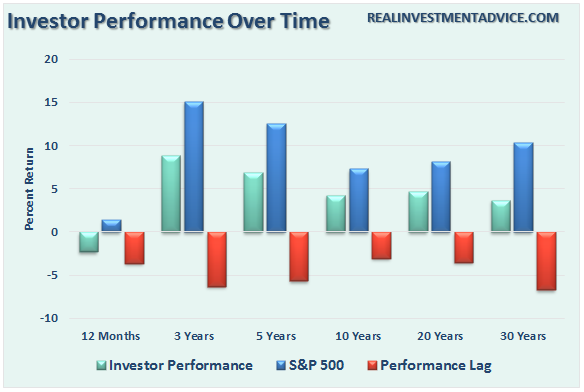

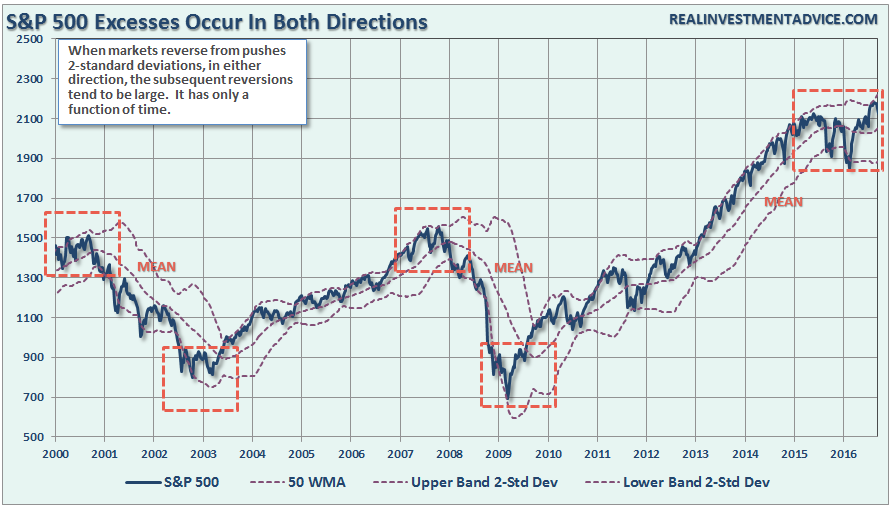
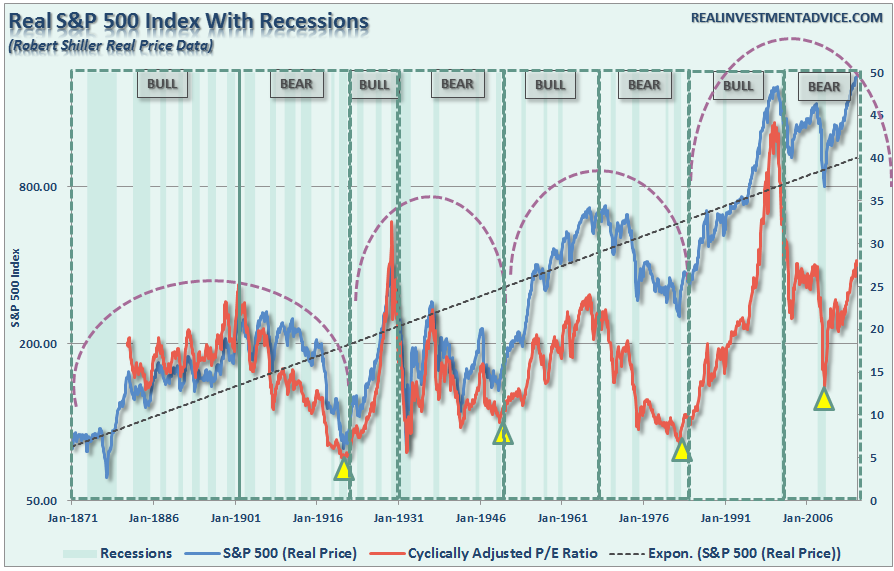
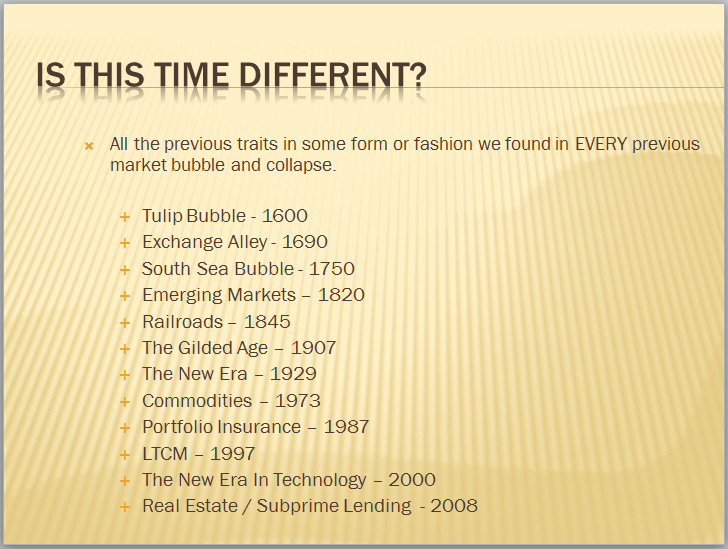
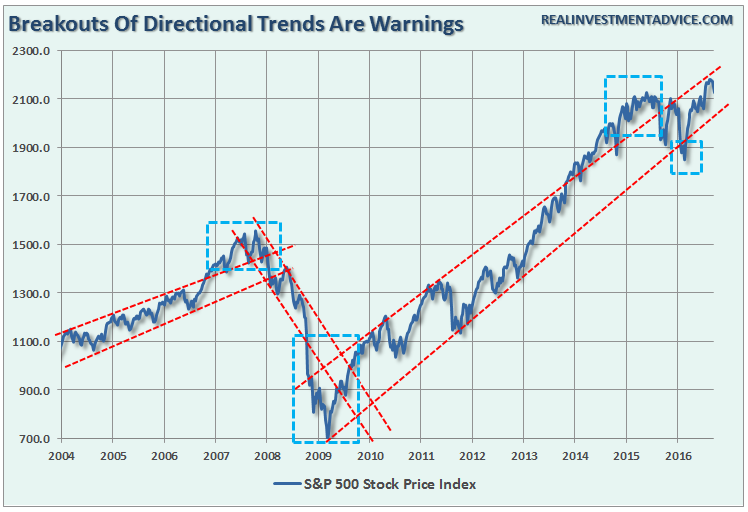
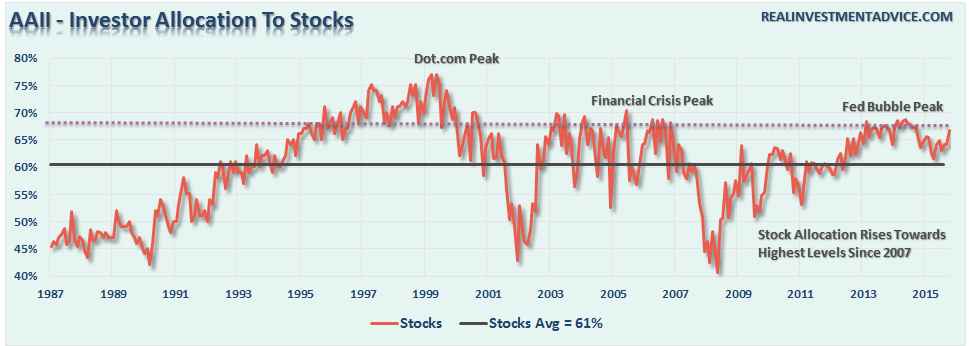
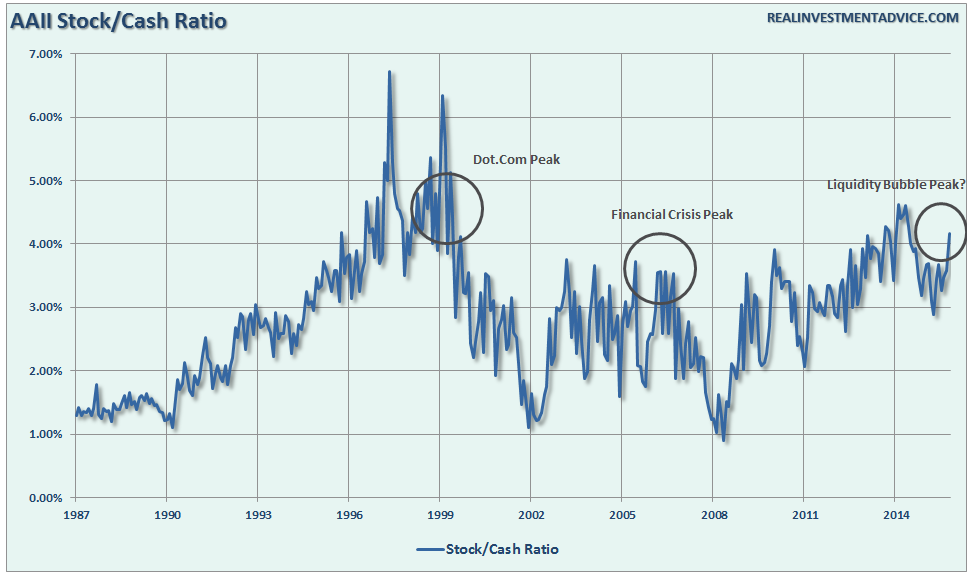
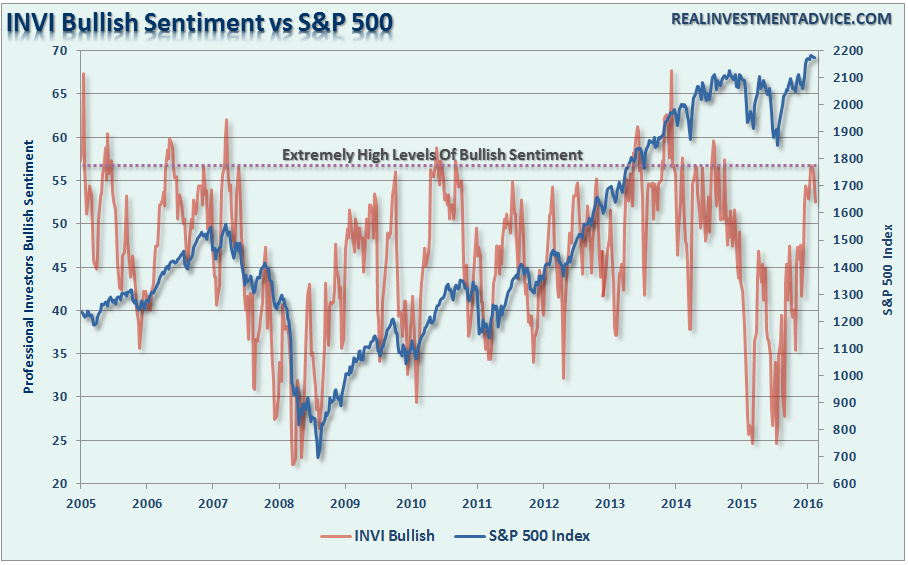
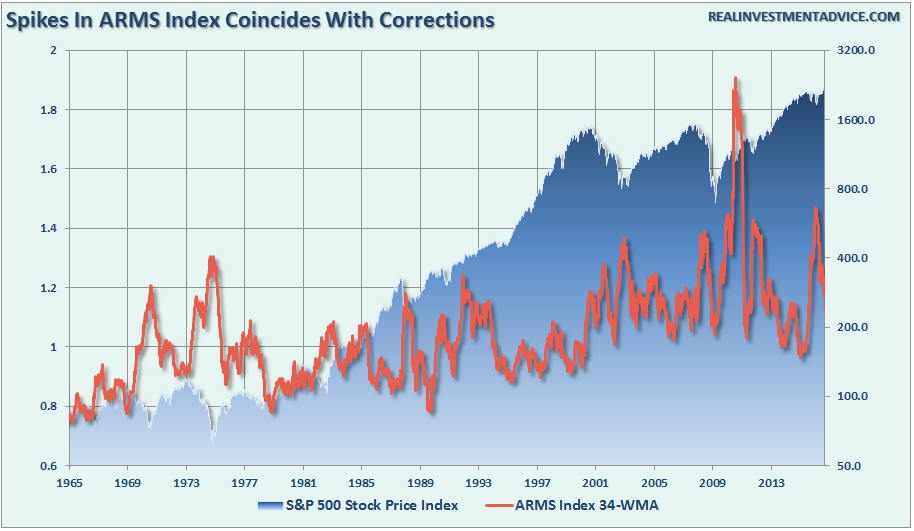


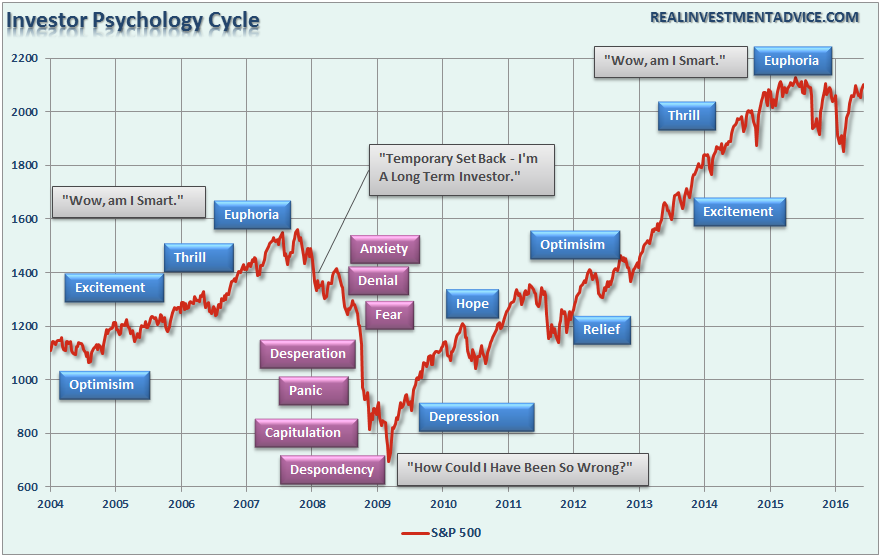
No comments:
Post a Comment